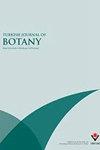帕迪纳和扎纳迪纳斯海洋大型藻类酚类化合物及生物活性的HPLC-UV分析
IF 1.5
4区 生物学
Q3 PLANT SCIENCES
引用次数: 0
摘要
tr摘要:海洋大型藻类以其优异的生物活性被认为是未来的食物。本研究旨在研究酚类化合物;细胞毒性、抗菌和抗氧化活性;木瓜(PP)和番荔枝(ZT)的甲醇、乙醇和水提取物的总酚(TPC)和黄酮(TFC)含量。据我们所知,这是第一份对ZT进行酚类含量、抗氧化、抗菌和细胞毒性评估的报告。高效液相色谱分析可以鉴定出所有提取物中含有芦丁(0.31±0.04–3.00±0.21 ppm)和MPP、EPP、MZT、EZT和WZT中反式-对-香豆酸(0.15±0.02–3.95±0.02 ppm)的五种酚类化合物为主要化合物。提取物的TPC和TFC分别计算为11.78±0.75–76.78±0.54µg GAEs/mg提取物和6.78±0.17–29.50±2.23µg QEs/mg提取物。EZT(CC 50:132.3±22.4µg/mL)对MCF-7和MZT(CC 50:91.4±20.9µg/mL。在所研究的提取物中,EPP对所有测试病原体显示出最佳的抗菌活性。此外,EPP对志贺邻单胞菌(MIC:1.25mg/mL)和金黄色葡萄球菌(MIC:11.25mg/mL)显示出优异的抗菌活性。EZT在DPPH•(IC 50:49.03±0.28µg/mL)、CURAC(A 0.50:15.20±0.14µg/mL.)和ABTS•+(IC 50:18.86±0.74µg/mL。结果表明,P.pavonica和Z.typus海洋大型藻类可作为食品和药理学应用的生物活性剂的天然来源。本文章由计算机程序翻译,如有差异,请以英文原文为准。
HPLC-UV analysis of phenolic compounds and biological activities of Padina pavonica and Zanardinia typus marine macroalgae species
tr Abstract: The marine macroalgae species are recognized as the food of the future with excellent bioactive properties. This study aimed to investigate phenolic compounds; cytotoxic, antibacterial, and antioxidant activities; total phenolic (TPC) and flavonoid (TFC) contents of the methanol, ethanol, and water extracts of Padina pavonica (PP) and Zanardinia typus (ZT) . To the best of our knowledge, this is the first report in which ZT was evaluated in terms of phenolic content, antioxidant, antibacterial, and cytotoxic activities. The HPLC analysis allowed the identification of five phenolic compounds containing rutin (0.31 ± 0.04 – 3.00 ± 0.21 ppm) in all extracts and trans - p -coumaric acid (0.15 ± 0.02 – 3.95 ± 0.02 ppm) in MPP, EPP, MZT, EZT, WZT as the major compounds. TPC and TFC of the extracts were calculated as 11.78 ± 0.75 – 76.78 ± 0.54 µg GAEs/mg extract and 6.78 ± 0.17 – 29.50 ± 2.23 µg QEs/mg extract, respectively. The highest cytotoxicity was observed in EZT (CC 50 : 132.3 ± 22.4 µg/mL) against MCF-7 and MZT (CC 50 : 91.4 ± 20.9 µg/mL) against MIA PaCa-2. Among the studied extracts, EPP showed the best antibacterial activity against all test pathogens. Also, EPP indicated superior antibacterial activity against Plesiomonas shigelloides (MIC: 1.25 mg/mL) and Staphylococcus aureus (MIC: 1.25 mg/mL). EZT displayed the highest antioxidant activity in DPPH • (IC 50 : 49.03 ± 0.28 µg/mL), CUPRAC (A 0.50 : 15.20 ± 0.14 µg/mL), and ABTS •+ (IC 50 : 18.86 ± 0.74 µg/mL) assays. The results approved that P. pavonica and Z. typus marine macroalgae species could be valued as natural sources of bioactive agents for food and pharmacology applications.
求助全文
通过发布文献求助,成功后即可免费获取论文全文。
去求助
来源期刊

Turkish Journal of Botany
PLANT SCIENCES-
CiteScore
2.90
自引率
5.60%
发文量
31
审稿时长
6-12 weeks
期刊介绍:
The Turkish Journal of Botany is published electronically 6 times a year by the Scientific and Technological Research Council of Turkey (TÜBİTAK) and accepts manuscripts (in English) covering all areas of plant biology (including genetics, evolution, systematics, structure, function, development, diversity, conservation biology, biogeography, paleobotany, ontogeny, functional morphology, ecology, reproductive biology, and pollination biology), all levels of organisation (molecular to ecosystem), and all plant groups and allied organisms (algae, fungi, and lichens). Authors are required to frame their research questions and discuss their results in terms of major questions in plant biology. In general, papers that are too narrowly focused, purely descriptive, or broad surveys, or that contain only preliminary data or natural history, will not be considered (*).
The following types of article will be considered:
1. Research articles: Original research in various fields of botany will be evaluated as research articles.
2. Research notes: These include articles such as preliminary notes on a study or manuscripts on the morphological, anatomical, cytological, physiological, biochemical, and other properties of plant, algae, lichen and fungi species.
3. Reviews: Reviews of recent developments, improvements, discoveries, and ideas in various fields of botany.
4. Letters to the editor: These include opinions, comments relating to the publishing policy of the Turkish Journal of Botany, news, and suggestions. Letters should not exceed one journal page.
(*) 1. Raw floristic lists (of algae, lichens, fungi, or plants), species descriptions, chorological studies, and plant sociology studies without any additional independent approaches.
2. Comparative morphology and anatomy studies (that do not cover a family, tribe, subtribe, genus, subgenus, section, subsection, or species complexes with taxonomical problems) without one or more independent additional approaches such as phylogenetical, micromorphological, chromosomal and anatomical analyses.
3. Revisions of family, tribe, genus, subgenus, section, subsection, or species complexes without any original outputs such as taxonomical status changes, IUCN categories, and phenological and ecological analyses.
4. New taxa of all plants without any additional independent approaches such as phylogenetical, ecological, chromosomal, chorological and correlational analyses in addition to a detailed macro- and micro-morphological descriptions with quality field and microscopic illustrations of taxonomically important structures and identification key in the taxonomic group.
New records of all plants without any additional independent approaches such as phylogenetical, ecological, chromosomal, chorological and correlational analyses in addition to a detailed macro- and micro-morphological descriptions with quality field and microscopic illustrations of taxonomically important structures and identification key in the taxonomic group may be accepted for peer review if they contain 3 or more new records or taxonomical status update, such as lectotypification, new combinations, transfers, revivals and synonyms.
5. New taxa of algae, lichens, and fungi without any additional independent approaches such as phylogenetical, ecological, chromosomal, chorological and correlational analyses in addition to a detailed macro- and micro-morphological descriptions with quality field and microscopic illustrations of taxonomically important structures and identification key in the taxonomic group.
New records of algae, lichens, and fungi without any additional independent approaches such as phylogenetical, ecological, chromosomal, chorological and correlational analyses in addition to a detailed macro- and micro-morphological descriptions with quality field and microscopic illustrations of taxonomically important structures and identification key in the taxonomic group may be accepted for peer review if they contain 5 or more new records or taxonomical status update, such as lectotypification, new combinations, transfers, revivals and synonyms.
 求助内容:
求助内容: 应助结果提醒方式:
应助结果提醒方式:


